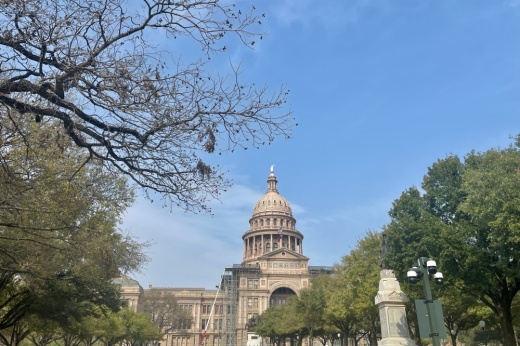House Bill 2, also known as the Property Tax Relief Act, was filed March 2 by Rep. Morgan Meyer, R-Dallas. According to a news release, the bill would cut school property taxes by 28% and prevent property values from increasing by more than 5% each year.
Property value is determined annually by county appraisal districts, which review all property in a county and determine how much it is worth. Under current state law, the appraised value of residential property can increase by 10% each year.
This change would “[shield] homeowners, small business owners and other property owners from sudden increases in values to their property that are oftentimes unsustainable,” the release said.
According to Phelan’s office, HB 2 would provide Texans with the largest property tax cut in state history. Homeowners would pay $460 less in property taxes in 2024 and $590 less in 2025, the release said.
Meyer also filed House Joint Resolution 1, which would propose adding the Property Tax Relief Act to the Texas Constitution as an amendment. The amendment would be added to election ballots, giving Texans the opportunity to vote on it on Nov. 7.
“Skyrocketing property taxes have become unaffordable for too many residents in this state, and I thank Rep. Meyer for filing legislation that would bring real relief to Texas taxpayers by making much-needed improvements to the state’s appraisal system,” Phelan said in the release. “This bill is a great building block for our state to continue to thrive, and I look forward to the Texas House passing House Bill 2 this legislative session.”
Property tax relief is also a top priority for Lt. Gov. Dan Patrick, who oversees the Texas Senate. Sen. Paul Bettencourt, R-Houston, filed a similar property tax relief bill, Senate Bill 3, on March 1. According to a news release, the bill would increase Texas’ homestead exemption—a reduction to a portion of a home’s value for tax purposes—to $70,000. Texans receive a $40,000 homestead exemption for their primary residence.
This would save homeowners $341 per year on their property tax bills, according to the release. Bettencourt also filed Senate Joint Resolution 3, which would create a constitutional amendment and allow Texans to vote on the property tax cuts.
All 31 state senators endorsed SB 3 and SJR 3, and their names are listed as joint authors.
During his State of the State address on Feb. 16, Gov. Greg Abbott announced seven emergency items, including property tax relief. Lawmakers can vote on legislation related to the governor’s emergency items immediately, rather than waiting until the traditional 60th day of the session, which is March 10.
Abbott has also asked lawmakers to use $15 billion to lower property tax rates for 2024-25, which aligns with the initial state budget proposed in the House and Senate.
Economic and workforce development
On Feb. 28, Phelan announced his support for three bills that are “aimed at defending the state’s economic growth.”
HB 5 was filed by Rep. Todd Hunter, R-Corpus Christi. Known as the Texas Jobs and Security Act, the legislation is meant to attract large businesses to Texas by allowing them to pay lower school district property taxes.
The bill would replace a program called Chapter 313, which allowed school districts to enter agreements with businesses to limit their property taxes for 10 years. During the 2021 legislative session, state lawmakers did not consider a bill extending Chapter 313, so the program expired at the end of 2022.
According to a news release, HB 5 would attract “capital-intensive” manufacturing, national security and energy projects to Texas, creating new jobs. The bill would also provide more information to taxpayers about the economic impact of new business projects and how state money is used to attract businesses.
Rep. Andrew Murr, R-Junction, filed HB 19, which would create a state business court system. All Texas counties would be included in the system. The new business court would take up cases specifically related to business and commerce, including lawsuits, trade regulation cases and more.
The special court system would “establish a new avenue for [companies] to solve their legal matters in a fair, streamlined and consistent manner,” the release said.
Rep. Gary VanDeaver, R-New Boston, filed HB 8. The bill would create a new funding model for community colleges across Texas, based on recommendations from the Texas Commission on Community College Finance. The commission was established by the Texas Legislature in 2021 and tasked with finding a new way to fund community colleges.
In October, the 12-member commission unanimously approved its recommendation to overhaul the state’s complicated allocation system and focus primarily on measurable student outcomes. Texas lawmakers received a report with the recommendations before the beginning of the current legislative session.
Commissioners recommended that community colleges be funded based on student outcomes, including graduation and transfer rates, credentials of value and credentials earned for high-demand fields. The commission also asked for an increase in need-based financial aid and work-based learning opportunities, and greater investments in college capacity through grants and cross-campus partnerships.
According to Phelan’s office, the legislation recognizes and rewards community colleges for the work they do to help students complete associate degrees, noncredit workforce education programs and more. These credentials will be required for over 60% of jobs in the next decade, the release said.
“As Texas continues to grow and attract even more business that creates jobs and spurs local economies, our state must ensure that we have the kinds of tools to keep us competitive with others on a national and global scale,” Phelan said in the release. “With so much job growth happening in our state, it’s also important that we have the necessary avenues that foster workforce development to keep up with demand.”





